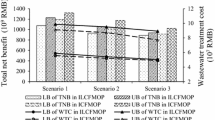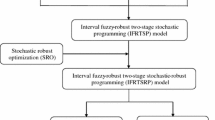Abstract
This paper presents an interactive fuzzy boundary interval programming (IFBIP) approach for addressing dual uncertainties that exist in the objective function and the left- and right-hand sides of constraints. IFBIP permits an interactive participation of the decision maker (DM) in all steps of the decision process through expressing his/her preferences in linguistic terms. A regional air quality management problem is studied to illustrate the proposed approach. The results indicate that a number of decision alternatives can be obtained under different feasibility degrees of constraints. They can help quantify the relationship between the total operating cost and the constraint violation risk, which is meaningful not only for supporting an in-depth analysis of the tradeoff between the economic objective and the system safety but also for the DM to identify a desired compromise between two conflicting concerns: the satisfaction degree of the goal and the feasibility degree of constraints.






Similar content being viewed by others
References
An, H., & Eheart, J. W. (2007). A screening technique for joint chance-constrained programming for air-quality management. Operations Research, 55(4), 792–798.
Bellman, R., & Zadeh, L. (1970). A. Decision making in a fuzzy environment. Management Science, 17(4), 141–164.
De Nevers, N. (2000). Air pollution control engineering. New York: McGraw-Hill.
Dong, W. M., & Shah, H. C. (1987). Vertex method for computing functions of fuzzy variables. Fuzzy Sets and Systems, 24(1), 65–78.
Dubois, D., & Prade, H. (1983). Ranking fuzzy numbers in the setting of possibility theory. Information Sciences, 30(3), 183–224.
Ellis, J. H., McBean, E. A., & Farquhar, G. J. (1985). Chance-constrained/stochastic linear programming model for acid rain abatement—I. Complete colinearity and noncolinearity. Atmospheric Environment, 19(6), 925–937.
Ellis, J. H., McBean, E. A., & Farquhar, G. J. (1986). Chance-constrained/stochastic linear programming model for acid rain abatement—II. Limited colinearity. Atmospheric Environment, 20(3), 501–511.
Environment Canada. (2011). National pollutant release inventory: air pollutant emission summaries and trends. Canada.
Fan, Y. R., & Huang, G. H. (2012). A robust two-step method for solving interval linear programming problems within an environmental management context. Journal of Environmental Informatics, 19(1), 1–9.
Fang, S. C., Hu, C. F., Wang, H. F., & Wu, S. Y. (1999). Linear programming with fuzzy coefficients in constraints. Computers & Mathematics with Applications, 37(10), 63–76.
Flagan, R. C., & Seinfeld, J. H. (1988). Fundamentals of air pollution engineering. Englewood Cliffs: Prentice-Hall.
Haith, D. A. (1982). Environmental systems optimization. New York: Wiley.
Heilpern, S. (1992). The expected valued of a fuzzy number. Fuzzy Sets and Systems, 47(1), 81–86.
Huang, G. H. (1996). IPWM: an interval parameter water quality management model. Engineering Optimization, 26(2), 79–103.
Huang, G. H. (1998). A hybrid inexact-stochastic water management model. European Journal of Operational Research, 107(1), 137–158.
Huang, G. H., Baetz, B. W., & Patry, G. G. (1992). A grey linear programming approach for municipal solid waste management planning under uncertainty. Civil Engineering Systems, 9(4), 319–335.
Jairaj, P. G., & Vedula, S. (2000). Multireservoir system optimization using fuzzy mathematical programming. Water Resources Management, 14(6), 457–472.
Jiménez, M., Arenas, M., Bilbao, A., & Rodriguez, M. V. (2007). Linear programming with fuzzy parameters: an interactive method resolution. European Journal of Operational Research, 177(3), 1599–1609.
Lai, Y. J., & Hwang, C. L. (1992). A new approach to some possibilistic linear programming problems. Fuzzy Sets and Systems, 49(2), 121–133.
Li, Y. P., & Huang, G. H. (2010). An interval-based possibilistic programming method for waste management with cost minimization and environmental-impact abatement under uncertainty. Science of the Total Environment, 408(20), 4296–4308.
Li, Y. P., Huang, G. H., Veawab, A., Nie, X. H., & Liu, L. (2006). Two-stage fuzzy-stochastic robust programming: a hybrid model for regional air quality management. Journal of the Air & Waste Management Association, 56(8), 1070–1082.
Li, Y. P., Huang, G. H., Guo, P., Yang, Z. F., & Nie, S. L. (2010). A dual-interval vertex analysis method and its application to environmental decision making under uncertainty. European Journal of Operational Research, 200(2), 536–550.
Liu, L., Huang, G. H., Liu, Y., Fuller, G. A., & Zeng, G. M. (2003). A fuzzy-stochastic robust programming model for regional air quality management under uncertainty. Engineering Optimization, 35(2), 177–199.
Loucks, D. P., & Beek, E. V. (2005). Water resources systems planning and management: an introduction to methods, models and applications. Paris: United Nations Educational, Scientific and Cultural Organization.
Lu, H. W., Huang, G. H., & He, L. (2010). A two-phase optimization model based on inexact air dispersion simulation for regional air quality control. Water, Air, and Soil Pollution, 211(1–4), 121–134.
Mula, J., Poler, R., & Garcia-Sabater, J. P. (2007). Material requirement planning with fuzzy constraints and fuzzy coefficients. Fuzzy Sets and Systems, 158(7), 783–793.
Pasquill, F. (1961). The estimation of the dispersion of windborne material. Meteorological Magazine, 90, 33–49.
Qin, X. S., Huang, G. H., Zeng, G. M., Chakma, A., & Huang, Y. F. (2007). An interval-parameter fuzzy nonlinear optimization model for stream water quality management under uncertainty. European Journal of Operational Research, 180(3), 1331–1357.
Qin, X. S., Huang, G. H., & Liu, L. (2010). A genetic-algorithm-aided stochastic optimization model for regional air quality management under uncertainty. Journal of the Air & Waste Management Association, 60(1), 63–71.
Turner, D.B. (1970). Workbook of atmospheric dispersion estimates. North Carolina: US EPA office of air programs publication NO AP-26.
Van Hop, N. (2007). Solving fuzzy (stochastic) linear programming problems using superiority and inferiority measures. Information Sciences, 177(9), 1977–1991.
Wang, S., & Huang, G. H. (2013a). A coupled factorial-analysis-based interval programming approach and its application to air quality management. Journal of the Air & Waste Management Association, 63(2), 179–189.
Wang, S., & Huang, G. H. (2013b). A two-stage mixed-integer fuzzy programming with interval-valued membership functions approach for flood-diversion planning. Journal of Environmental Management, 117, 208–218.
Wang, S., Huang, G. H., Lu, H. W., & Li, Y. P. (2011). An interval-valued fuzzy linear programming with infinite α-cuts method for environmental management under uncertainty. Stochastic Environmental Research and Risk Assessment, 25(2), 211–222.
Wang, S., Huang, G. H., & Yang, B. T. (2012). An interval-valued fuzzy-stochastic programming approach and its application to municipal solid waste management. Environmental Modelling & Software, 29(1), 24–36.
Wang, S., Huang, G. H., & Veawab, A. (2013). A sequential factorial analysis approach to characterize the effects of uncertainties for supporting air quality management. Atmospheric Environment, 67, 304–312.
WHO (2005). Air quality guidelines for particulate matter, ozone, nitrogen dioxide and sulfur dioxide—global update 2005—summary of risk assessment.
Yager, R.R. (1979). Ranking fuzzy subsets over the unit interval. In: Proceedings of 17th IEEE International Conference on Decision and Control (pp. 1435–1437). San Diego.
Zadeh, L. A. (1965). Fuzzy sets. Information and Control, 8(3), 338–353.
Zadeh, L.A. (1975). The concept of a linguistic variable and its applications to approximate reasoning. Information Sciences, Part I 8, 199–249; Part II 8, 301–357; Part III 9, 43–80.
Zadeh, L. A. (1978). Fuzzy sets as a basis for a theory of possibility. Fuzzy Sets and Systems, 1, 3–28.
Zimmerman, H. J. (2001). Fuzzy sets theory—and its applications. Boston: Kluwer.
Acknowledgments
This research was supported by the Program for Innovative Research Team (IRT1127), the Natural Science and Engineering Research Council of Canada, and the MOE Key Project Program (311013). The authors would like to express thanks to the editor and the anonymous reviewers for their constructive comments and suggestions.
Author information
Authors and Affiliations
Corresponding author
Rights and permissions
About this article
Cite this article
Wang, S., Huang, G.H. Interactive Fuzzy Boundary Interval Programming for Air Quality Management Under Uncertainty. Water Air Soil Pollut 224, 1574 (2013). https://doi.org/10.1007/s11270-013-1574-5
Received:
Accepted:
Published:
DOI: https://doi.org/10.1007/s11270-013-1574-5




